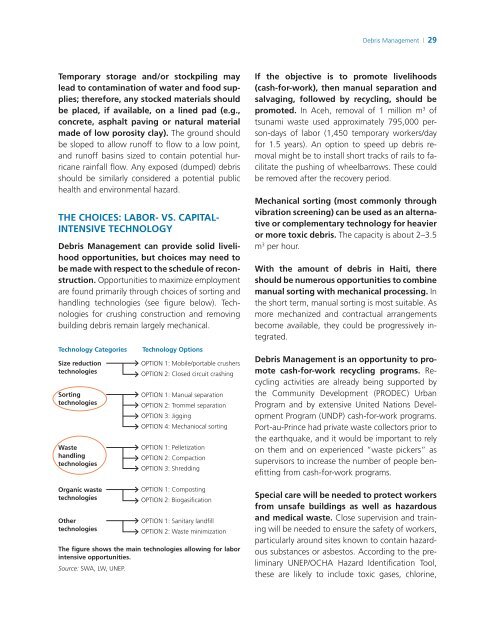Haiti Earthquake Reconstruction Knowledge Notes from ... - GFDRR
Haiti Earthquake Reconstruction Knowledge Notes from ... - GFDRR
Haiti Earthquake Reconstruction Knowledge Notes from ... - GFDRR
You also want an ePaper? Increase the reach of your titles
YUMPU automatically turns print PDFs into web optimized ePapers that Google loves.
Debris Management | 29<br />
Temporary storage and/or stockpiling may<br />
lead to contamination of water and food supplies;<br />
therefore, any stocked materials should<br />
be placed, if available, on a lined pad (e.g.,<br />
concrete, asphalt paving or natural material<br />
made of low porosity clay). The ground should<br />
be sloped to allow runoff to flow to a low point,<br />
and runoff basins sized to contain potential hurricane<br />
rainfall flow. Any exposed (dumped) debris<br />
should be similarly considered a potential public<br />
health and environmental hazard.<br />
THE CHOICES: LABOR- VS. CAPITAL-<br />
INTENSIVE TECHNOLOGY<br />
Debris Management can provide solid livelihood<br />
opportunities, but choices may need to<br />
be made with respect to the schedule of reconstruction.<br />
Opportunities to maximize employment<br />
are found primarily through choices of sorting and<br />
handling technologies (see figure below). Technologies<br />
for crushing construction and removing<br />
building debris remain largely mechanical.<br />
Technology Categories<br />
Size reduction<br />
technologies<br />
Sorting<br />
technologies<br />
Waste<br />
handling<br />
technologies<br />
Organic waste<br />
technologies<br />
Other<br />
technologies<br />
Technology Options<br />
Option 1: Mobile/portable crushers<br />
OPTION 2: Closed circuit crashing<br />
OPTION 1: Manual separation<br />
OPTION 2: Trommel separation<br />
OPTION 3: Jigging<br />
OPTION 4: Mechaniocal sorting<br />
OPTION 1: Pelletization<br />
OPTION 2: Compaction<br />
OPTION 3: Shredding<br />
OPTION 1: Composting<br />
OPTION 2: Biogasification<br />
OPTION 1: Sanitary landfill<br />
OPTION 2: Waste minimization<br />
The figure shows the main technologies allowing for labor<br />
intensive opportunities.<br />
Source: SWA, LW, UNEP.<br />
If the objective is to promote livelihoods<br />
(cash-for-work), then manual separation and<br />
salvaging, followed by recycling, should be<br />
promoted. In Aceh, removal of 1 million m 3 of<br />
tsunami waste used approximately 795,000 person-days<br />
of labor (1,450 temporary workers/day<br />
for 1.5 years). An option to speed up debris removal<br />
might be to install short tracks of rails to facilitate<br />
the pushing of wheelbarrows. These could<br />
be removed after the recovery period.<br />
Mechanical sorting (most commonly through<br />
vibration screening) can be used as an alternative<br />
or complementary technology for heavier<br />
or more toxic debris. The capacity is about 2–3.5<br />
m 3 per hour.<br />
With the amount of debris in <strong>Haiti</strong>, there<br />
should be numerous opportunities to combine<br />
manual sorting with mechanical processing. In<br />
the short term, manual sorting is most suitable. As<br />
more mechanized and contractual arrangements<br />
become available, they could be progressively integrated.<br />
Debris Management is an opportunity to promote<br />
cash-for-work recycling programs. Recycling<br />
activities are already being supported by<br />
the Community Development (PRODEC) Urban<br />
Program and by extensive United Nations Development<br />
Program (UNDP) cash-for-work programs.<br />
Port-au-Prince had private waste collectors prior to<br />
the earthquake, and it would be important to rely<br />
on them and on experienced “waste pickers” as<br />
supervisors to increase the number of people benefitting<br />
<strong>from</strong> cash-for-work programs.<br />
Special care will be needed to protect workers<br />
<strong>from</strong> unsafe buildings as well as hazardous<br />
and medical waste. Close supervision and training<br />
will be needed to ensure the safety of workers,<br />
particularly around sites known to contain hazardous<br />
substances or asbestos. According to the preliminary<br />
UNEP/OCHA Hazard Identification Tool,<br />
these are likely to include toxic gases, chlorine,

















